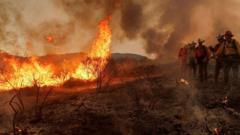Will California's Rapidly Growing Fire Force Thousands to Evacuate?

The Impact of Wildfires in California: A Closer Look at the Canyon Fire
As wildfires continue to plague California, the recent Canyon Fire has escalated concerns among residents and officials alike. This fast-growing wildfire, which erupted northwest of Los Angeles, has prompted mandatory evacuations for thousands. With extreme heat and dry conditions contributing to its rapid spread, the fire quickly expanded from a mere 30 acres to nearly 5,000 acres within a day. Understanding the dynamics of such wildfires, their causes, and the safety measures is crucial for residents living in fire-prone areas.
Understanding the Canyon Fire
The Canyon Fire ignited on Thursday afternoon along the border of Ventura and Los Angeles counties. By Friday morning, the fire was already reported to be out of control, with officials stating it was "0% contained." The Ventura County Fire Department has mandated evacuations for over 2,700 residents, while an additional 14,000 people have been issued evacuation warnings. The blaze highlights the urgent need for preparedness and awareness in fire-prone areas, especially as the National Weather Service predicts soaring temperatures of up to 100°F (37.7°C) in the following days.
Evacuation and Safety Measures
In light of such emergencies, local officials have been proactive in issuing evacuation orders. Santa Clarita, one of the cities closest to the Canyon Fire, has been under high alert. Authorities have advised residents to heed evacuation orders seriously. LA County Supervisor Kathryn Barger has emphasized the importance of immediate evacuation when first responders issue such directives, stating, "If you're in Santa Clarita, Hasley Canyon, or Val Verde, take evacuation orders seriously." This underscores the importance of preparedness and staying informed during wildfire season.
What to Do If You Are Asked to Evacuate
If you receive an evacuation order, follow these steps to ensure your safety:
- Stay Informed: Keep updated on the fire’s status through official channels.
- Prepare a Go-Bag: Pack essential items such as medications, important documents, clothing, and personal items.
- Evacuate Early: Don’t wait until the last minute to leave; prioritize your safety.
- Communicate: Inform family and friends of your evacuation plans.
The Role of Climate Change in Wildfire Frequency
Wildfires have become increasingly frequent and destructive in California, with climate change playing a significant role. Experts point to hotter and drier conditions as key factors contributing to the length and severity of fire seasons. The Canyon Fire is one of many active wildfires across the state, which includes the Gifford Fire, the largest active blaze consuming nearly 100,000 acres across San Luis Obispo and Santa Barbara counties.
Climate Change and Wildfire Dynamics
Understanding the relationship between climate change and wildfires is essential for developing effective response strategies. Here are some critical aspects to consider:
- Extended Dry Seasons: Climate change has led to prolonged dry seasons, making vegetation more susceptible to ignition.
- Increased Temperatures: Rising temperatures can create conditions conducive to fire spread.
- Changing Weather Patterns: Unpredictable weather can exacerbate wildfire risks.
Past Wildfires: Lessons Learned
This year has already seen devastating wildfires, such as the Eaton Fire, which tore through Altadena, killing at least 31 people and destroying thousands of structures. Each wildfire serves as a stark reminder of the importance of preparedness and community awareness in mitigating risks. Learning from past events can help residents better prepare for future emergencies.
Key Takeaways from Previous Fires
From historical wildfire events, the following lessons have emerged:
- Preparedness is Key: Communities should have evacuation plans and emergency kits ready.
- Community Engagement: Local organizations and leaders can play a role in spreading awareness and preparedness strategies.
- Policy Advocacy: Advocating for sustainable land management and fire prevention policies can significantly reduce wildfire risks.
Conclusion: The Importance of Vigilance and Preparedness
The Canyon Fire is a wake-up call to residents in fire-prone areas. As climate change continues to influence wildfire dynamics, understanding the risks and taking proactive steps can save lives and property. It's crucial for communities to remain vigilant, stay informed, and prioritize safety during wildfire season.
FAQs
What should I include in my evacuation kit?
Your evacuation kit should include essentials such as medications, important documents, clothing, food, water, and personal items that hold sentimental value.
How can I stay informed about wildfire updates?
Stay informed through local news, official social media channels, and emergency services notifications for real-time updates on wildfire status and evacuation orders.
What are the long-term effects of wildfires on the environment?
Wildfires can lead to soil erosion, loss of wildlife habitat, and air quality issues. They can also affect water quality in nearby rivers and lakes.
As we witness the growing frequency and intensity of wildfires like the Canyon Fire, how can we collectively work towards better preparedness and community resilience? #WildfireSafety #CanyonFire #ClimateChange
Published: 2025-08-08 15:00:35 | Category: wales



